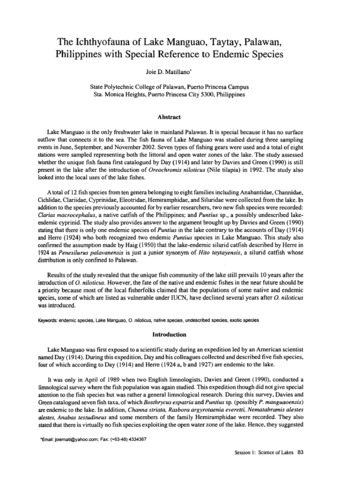Larval and early juvenile development of silver therapon, Leiopotherapon plumbeus (Actinopterygii: Perciformes: Terapontidae), reared in mesocosms
| dc.contributor.author | Aya, Frolan | |
| dc.contributor.author | Corpuz, Mark Nell C. | |
| dc.contributor.author | Laron, Manuel A. | |
| dc.contributor.author | Garcia, Luis Maria | |
| dc.date.accessioned | 2018-05-23T06:11:24Z | |
| dc.date.available | 2018-05-23T06:11:24Z | |
| dc.date.issued | 2017 | |
| dc.identifier.citation | Aya, F. A., Copruz, M. N. C., Laron, M. A., & Garcia, L. M. B. (2017). Larval and early juvenile development of silver therapon, Leiopotherapon plumbeus (Actinopterygii: Perciformes: Terapontidae), reared in mesocosms. Acta Ichthyologica et Piscatoria, 47(4), 347-356. | en |
| dc.identifier.issn | 0137-1592 | |
| dc.identifier.uri | http://hdl.handle.net/10862/3295 | |
| dc.description.abstract | The silver therapon, Leiopotherapon plumbeus (Kner, 1864), is an endemic and economically important freshwater food fish in the Philippines. The natural populations of this species have been declining during the past years, mainly due to intense fishing pressure, habitat degradation, and introduction of invasive alien species. At present, it is considered a target species for domestication and conservation efforts. Despite several attempts of artificial reproduction and larval rearing, little is known on larval and early juvenile development of silver therapon. The presently reported study was therefore intended to fill this gap in the knowledge by determining the growth and describing body proportions, pigmentation, and fin formation of this fish. Newly hatched larvae were reared in mesocosm tanks at a mean temperature of 29.5°C. Larvae up to 30 days after hatching were sampled at irregular intervals and preserved in 5% buffered formalin. Early development stages for 245 preserved specimens were described in detail with reference to changes in morphology, growth and body proportions, pigmentation, and fin formation. Five developmental stages of silver therapon were identified: yolk sac larva (1.88 mm TL), preflexion (2.51 mm TL), notochord flexion (4.50-8.27 mm TL), postflexion larva (6.90-12.21 mm TL), and early juvenile (>13.40 mm TL). Growth was isometric for eye diameter and gape size whereas positive allometry was observed for body depth, head length, and preanal length. Some body proportions showed abrupt changes from preflexion to postflexion larvae before it stabilized during the early juvenile stage. Pigmentation in the form of stellate and punctate melanophores increased with developmental stage, with larvae becoming heavily pigmented from postflexion to early juvenile stage. These morphological changes, together with the full complement of fin rays and squamation observed in specimens larger than 13.4 mm TL, suggest the attainment of the juvenile stage of this species. These morphological changes may explain the food and feeding habits during the early life stages of silver therapon which is critical to their survival and recruitment in the wild and in a mesocosm hatchery environment. | en |
| dc.description.sponsorship | This work was supported by SEAFDEC Aquaculture Department under the Study code: Nr-04- F2010B. We express our gratitude to Miss Julie Andrea P. Añano, Mr Nemencio B. Olorvida and the student interns from the Polytechnic University of the Philippines (Santa Mesa, Manila) for their assistance during the study. | en |
| dc.language.iso | en | en |
| dc.publisher | Szczecińskie Towarzystwo Naukowe | en |
| dc.relation.uri | http://www.aiep.pl/volumes/2010/8_4/pdf/04_2222_F1.pdf | |
| dc.subject | Philippines | en |
| dc.subject | yolk sac | en |
| dc.subject | land degradation | en |
| dc.subject | pigmentation | en |
| dc.subject | habits | en |
| dc.title | Larval and early juvenile development of silver therapon, Leiopotherapon plumbeus (Actinopterygii: Perciformes: Terapontidae), reared in mesocosms | en |
| dc.type | Article | en |
| dc.identifier.doi | 10.3750/AIEP/02222 | |
| dc.citation.volume | 47 | |
| dc.citation.issue | 4 | |
| dc.citation.spage | 347 | |
| dc.citation.epage | 356 | |
| dc.citation.journalTitle | Acta Ichthyologica et Piscatoria | en |
| dc.subject.asfa | fishing effort | en |
| dc.subject.asfa | freshwater fishes | en |
| dc.subject.asfa | fish | en |
| dc.subject.asfa | environmental degradation | en |
| dc.subject.asfa | domestication | en |
| dc.subject.asfa | food | en |
| dc.subject.asfa | fisheries | en |
| dc.subject.asfa | allometry | en |
| dc.subject.asfa | inland water environment | en |
| dc.subject.asfa | developmental stages | en |
| dc.subject.asfa | commercial fishing | en |
| dc.subject.asfa | population | en |
| dc.subject.asfa | biology | en |
| dc.subject.asfa | fins | en |
| dc.subject.asfa | introduced species | en |
| dc.subject.asfa | hatching | en |
| dc.subject.asfa | growth | en |
| dc.subject.asfa | fishing | en |
| dc.subject.asfa | endemic species | en |
| dc.subject.asfa | larvae | en |
| dc.subject.asfa | nature conservation | en |
| dc.subject.asfa | induced ovulation | en |
| dc.subject.asfa | biodegradation | en |
| dc.subject.asfa | tanks | en |
| dc.subject.asfa | chromatophores | en |
| dc.subject.asfa | juveniles | en |
| dc.subject.asfa | rearing techniques | en |
| dc.subject.asfa | species | en |
| dc.subject.asfa | mesocosms | en |
| dc.subject.asfa | food fish | en |
| dc.subject.asfa | hatcheries | en |
| dc.subject.asfa | egg yolk | en |
| dc.subject.asfa | reproduction | en |
| dc.subject.asfa | animal morphology | en |
| dc.subject.asfa | meristic counts | en |
| dc.subject.asfa | catch-effort | en |
| dc.identifier.essn | 1734-1515 | |
| dc.subject.scientificName | Leiopotherapon plumbeus | en |
| local.subject | growth | en |
| local.subject | morphology | en |
| local.subject | body proportion | en |
| local.subject | fish larvae | en |
このアイテムのファイル
| ファイル | サイズ | フォーマット | 閲覧 |
|---|---|---|---|
|
このアイテムに関連するファイルは存在しません。 |
|||
このアイテムは次のコレクションに所属しています
-
Journal Articles [1256]
These papers were contributed by Department staff to various national and international journals.



